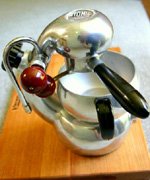
I recently picked up a couple of spare head filters. I was just going to chuck them in my parts box when I noticed the hole patterns were different. That made me go and check all my machines to see what patterns were in the head filters. The results surprised me.
My early flat-top Gorrea has a filter with a regular hole pattern around a single, centered fixing screw. The next oldest machine, a Sassoon model with steamer wand in the head, also has a regular hole pattern, but with two fixing screws. The later machines, Robbiati, Bon Trading and La Sorrentina, all have star patterns in the head filter, as well as the two fixing screws.
What do we conclude from this? Well, when you find the star pattern in the filter basket, it generally indicates a "vintage" Atomic (anything from 1950s to 1980s), but when you find it in the head filter, it seems to indicate a later model.
Anyone else able to add to this mini-research-project? Like, for example, which came first - the five-pointed star or the six-pointed one?






